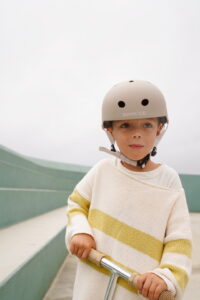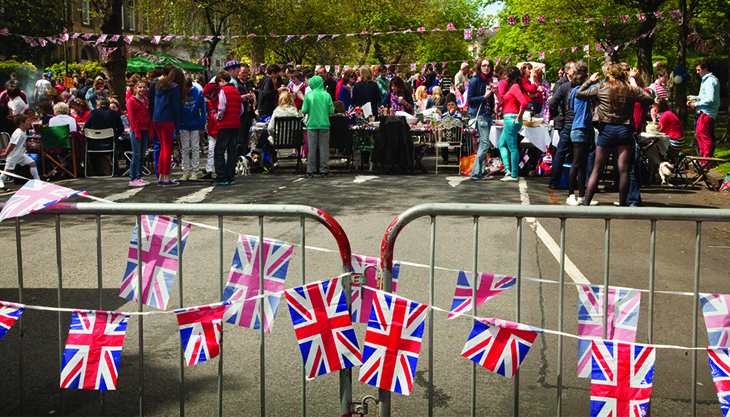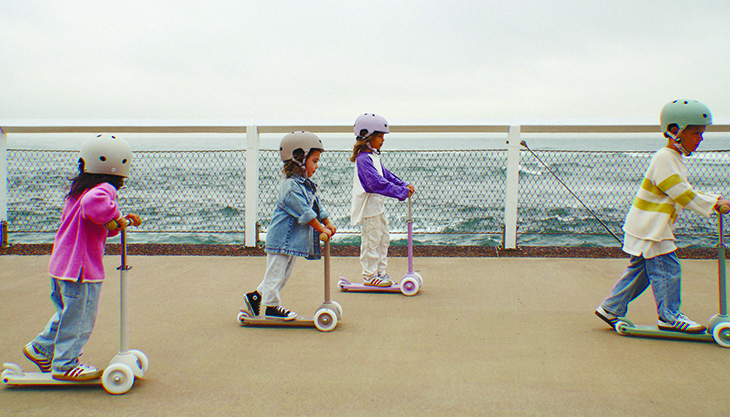
Your first Scooter: Banwood’s guide to getting your children scootering safely.
Learning to ride a scooter will develop your little one’s coordination, balance, and fine motor skills, increasing self-esteem and spatial awareness.
Safety features of Banwood scooters to help prevent common accidents among younger riders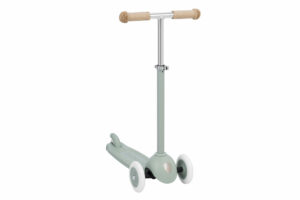
Banwood scooters, known for their stylish designs and high-quality materials, incorporate several safety features to reduce the risk of accidents, especially for younger riders.
Banwood scooters are equipped with a textured anti-slip surface on a wide deck to help kids maintain a stable footing while riding.
The low deck design lowers the centre of gravity, which improves stability and makes it easier for younger riders to balance while riding. This is particularly helpful for kids who are still developing coordination and balance.
The handlebars are usually designed with soft, durable rubber grips that provide a secure hold, even in wet conditions. This reduces the likelihood of hands slipping off the handlebars during turns or sudden movements.
Banwood scooters are equipped with an easy-to-use rear brake that allows kids to stop smoothly and safely. The rear brake is foot-operated, making it intuitive for younger riders to engage.
The wheels on Banwood scooters are typically wider and made from high-quality materials, such as rubber, which enhances grip and smoothness of the ride.
Banwood ECO Scooters feature a three-wheel design (two in the front, one in the back) that provides extra balance and stability. This is especially useful for younger or beginner riders who may still be learning how to steer or balance on two wheels.
These wheels help prevent tipping and ensure better control, even on uneven surfaces.
The handlebars on Banwood scooters are adjustable, allowing them to grow with the child. This feature ensures that the rider can maintain a comfortable and ergonomic posture, which is important for control and safety.
Advice for parents who are buying a scooter for their child for the first time
Make sure the scooter is suited for your child’s age group. Younger kids (3-5 years old) may benefit from a 3-wheeled scooter that offers better balance and stability, while older kids (6 years and up) can handle 2-wheeled models.
If your child is a beginner, look for scooters with a low deck height, which makes it easier to balance. A scooter with a wider deck and softer wheels may also help with stability.
Lightweight scooters are easier for kids to handle and control. Make sure the scooter isn’t too heavy for your child to carry, especially if they’re likely to want to pick it up and walk with it at times.
The scooter should be the right size for your child. When standing on the deck, their feet should be able to touch the ground comfortably. The handlebars should also be at a height that allows them to ride comfortably without hunching over.
While it’s tempting to go for the cheapest option, it’s often worth investing a bit more in a reputable brand. Trusted brands usually have better safety features, customer service, and durability. Banwood, for example, is known for combining both style and safety in their scooters.
The importance of wearing helmets and other protective gear while scootering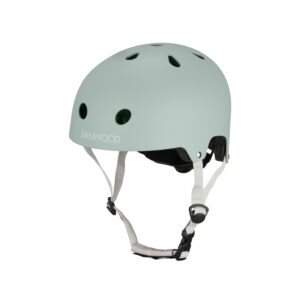
Wearing helmets and other protective gear is crucial for ensuring your child’s safety while scootering. While scootering is a fun and exciting activity, it comes with the risk of falls, especially for beginners who are still learning how to balance and control the scooter.
Studies have shown that helmets reduce the risk of head injury by up to 85%. It’s one of the easiest and most effective ways to protect your child while they’re having fun. Wearing the proper protective gear not only helps prevent injuries, but it also boosts your child’s confidence. When they know they’re well-protected, they’re more likely to enjoy their ride and focus on developing their skills rather than worrying about the possibility of getting hurt.
Wearing gear consistently also teaches your child the importance of safety and instills good habits early on. It sets the foundation for a lifetime of being mindful of safety when participating in any kind of sport or activity.
As a parent, modelling good safety behaviour is important. If you wear your helmet and protective gear while biking, scootering, or engaging in other activities, your child is more likely to follow suit. Leading by example teaches them that safety is a priority, not just something optional.
While it may seem like a hassle to always get your child to wear their full protective gear, it’s a small effort compared to the potential consequences of an injury. It’s worth noting that most scooter accidents involve falls, but by ensuring your child wears a helmet, knee pads, elbow pads, and wrist guards, you drastically reduce the risk of severe injury.
Types of terrain where Banwood scooters perform best
Banwood scooters are best suited for smooth, paved surfaces, such as city pavements, bike lanes, park pathways, and well-maintained urban streets. They perform well on light gravel and compact dirt, but should be kept away from rocky, sandy, or highly uneven terrains. For families looking for a fun, stylish scooter for city rides, park visits, and leisurely cruising, Banwood offers a safe and smooth experience. For rougher, off-road adventures, other types of scooters designed specifically for dirt trails and uneven terrain might be a better fit.
Soft rubber wheels provide better traction and a smoother ride, especially on uneven or rough surfaces. Larger wheels tend to offer a smoother ride overall, but can be harder for smaller children to control.
Teaching children safe riding habits and basic road or path etiquette
Create a rule that no helmet = no ride. This will reinforce the habit and ensure your child understands the importance of protection.
Emphasize the importance of looking both ways before crossing the street, even if the light is green. Teach them to look left, right, and left again to ensure no cars, bikes, or other scooters are coming.
When riding on shared paths or pavements, remind your child to always yield to pedestrians. Slow down when approaching people walking, and be ready to give them space by passing with caution.
Children should understand that they need to be predictable when riding. Suddenly darting across the road, swerving unexpectedly, or cutting in front of others can cause accidents. Teach them to maintain a steady line and make turns only when it’s safe.
Encourage your child to constantly scan the environment for obstacles (like debris, puddles, or cracks) and be aware of any other vehicles or riders nearby.
When your child is just learning the basics, practice in low-traffic areas like quiet residential streets, parks, or schoolyards. This allows them to get comfortable without the added risk of vehicles and other scooters.
Teach your child that speeding or trying to race on their scooter is unsafe, especially in crowded areas or around corners. Encourage them to ride at a comfortable pace where they can maintain control of the scooter at all times.
Tips to help children build balance and coordination gradually and safely
A low deck height makes it easier for children to reach the ground with their feet, giving them better control over their balance. It also lowers the centre of gravity, which helps prevent tipping over.
A large, flat area with no obstacles (like a park or an empty parking lot) is ideal for practicing balance. This lets kids gain confidence without worrying about navigating traffic or uneven surfaces.
Start by having your child push with one foot while keeping the other foot on the deck. Encourage them to glide for a few seconds before pushing again. Gradually, they’ll be able to glide for longer periods, building both balance and confidence.
Start by encouraging your child to gently steer in a straight line, using small movements of the handlebars. As they get more comfortable, have them practice turning in larger circles. Make sure they keep their weight centred over the scooter for stability.
Teach your child to gradually use the foot brake to slow down and stop. Practice this by encouraging them to gently press down on the brake and come to a gradual halt rather than stopping abruptly. As they become more comfortable, they will better understand how to control their speed.
Once your child is comfortable gliding with one foot, encourage them to alternate feet during the push-glide cycle. This builds coordination and balance by engaging different muscles on each side of the body.
Set up a simple balance challenge like asking your child to balance on their scooter for a few seconds without moving or practicing gliding in a straight line while keeping both feet on the deck. Progressively make the challenges more difficult as they improve.
Play games like “Simon Says” where they have to balance and do various actions like “glide with one foot” or “turn to the left.” You can also set up a simple obstacle course that they need to navigate slowly to practice control.
Keep practice sessions short and sweet — about 10-15 minutes at a time, and then take a break. Focus on building balance in a relaxed and positive environment.
Celebrate small victories, like successfully gliding for a few seconds or making a turn. Positive feedback, even for small milestones, will boost their confidence and encourage them to keep trying.
